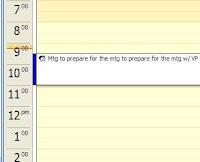
The need for this is that it allows the executive admin to print out this info and provide a professional brief, it supports last minutes changes, and informs the customer of key requirements such as a Projector. Just imagine how comfortable an executive feels when he has to forward your invite to his boss!
So here are the basics the invite should contain, the idea here is to make you think about it when you send it out.
NAME OF THE COMPANY
Brief written intro on how the meeting came to be, and what the objective of the meeting is.
When: February 24, 1.30pm - 3.00pm (local time)
Where: Customer office at
One Third Street
Great City, CA
Who:
John Smith, VP of Network Architecture
Sue Doe, SVP Corporate Communications
Jacco vdK, VP Sales
Chris M, Account Executive
How: All will be physically present (if not provide conference/Webex login)
What: Proposed Agenda
> Introduction
> Topic 1
> Topic 2
> Summary of actions
Other:
> Projector needed - Yes/No
> Open broadband connection needed - Yes/No
> Parking instructions - Yes (detail) / No
> Dress code - Business Casual / Formal / Casual
Contact info:
In case of last minute changes do not hesitate to contact me
Jacco cell (xxx) xxx - xxxx
John admin (xxx) xxx - xxxx
References:
> Related document / RFP / etc.
> Presentation / Hand-out / PR / etc.
> Map / Driving directions
End.































